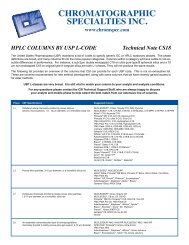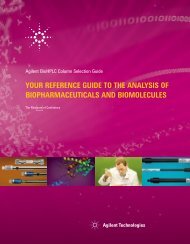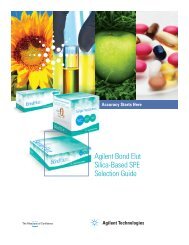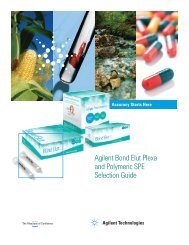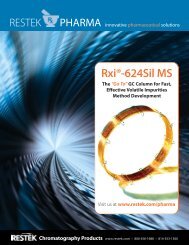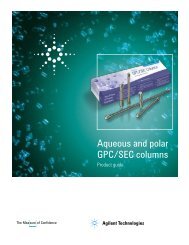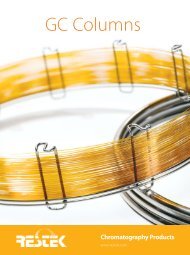Optimizing the Analysis of Volatile Organic Compounds
Optimizing the Analysis of Volatile Organic Compounds
Optimizing the Analysis of Volatile Organic Compounds
You also want an ePaper? Increase the reach of your titles
YUMPU automatically turns print PDFs into web optimized ePapers that Google loves.
Applications Using GC Detection Systems<br />
Purge and Trap Applications Using Tandem PID-ELCD:<br />
US EPA Methods 502.2, 601, 602, 8010, 8020, 8021B<br />
EPA methods for GC analyses <strong>of</strong> volatile compounds require purge and trap units for concentrating<br />
<strong>the</strong> contaminants in water, soil, or wastewater. While purge and trap concentration<br />
significantly increases sensitivity, relative to o<strong>the</strong>r sample introduction techniques, it does<br />
have a downside: early-eluting volatile compounds typically exhibit broad peaks, due to<br />
inefficient sample transfer from <strong>the</strong> trap to <strong>the</strong> GC. This distorted peak shape decreases resolution<br />
between closely eluting compounds, placing demands on <strong>the</strong> analytical system and<br />
requiring optimized GC operating conditions. Although cry<strong>of</strong>ocusing improves separations<br />
<strong>of</strong> early eluting compounds, most environmental laboratories do not use this approach<br />
because it increases costs.<br />
EPA methods for monitoring volatiles by GC <strong>of</strong>ten recommend using a PID and an ELCD,<br />
connected in tandem or series. Coelutions <strong>of</strong> target compounds are allowed, as long as <strong>the</strong>y<br />
are resolved by <strong>the</strong> detectors. 13 For example, in Figure 39 brom<strong>of</strong>orm and styrene elute with<br />
<strong>the</strong> same retention time, but brom<strong>of</strong>orm elicits a response only from <strong>the</strong> ELCD and styrene<br />
elicits a response only from <strong>the</strong> PID. Thus, <strong>the</strong> selective detectors resolve <strong>the</strong>se two compounds.<br />
Because it characteristically produces tailing peaks, <strong>the</strong> ELCD is <strong>the</strong> more problematic<br />
<strong>of</strong> <strong>the</strong> two detectors; sensitivity can be increased, but not without a sacrifice in peak<br />
shape. Optimization <strong>of</strong> an ELCD minimizes tailing and maximizes sensitivity.<br />
<strong>Analysis</strong> Time: Several factors contribute to <strong>the</strong> total analysis time for volatiles separations,<br />
including purge and trap cycle time, sample analysis time, and GC oven cool-down time<br />
(time required for <strong>the</strong> oven to cool from <strong>the</strong> final temperature to <strong>the</strong> initial temperature for<br />
<strong>the</strong> next analysis). Long purge and trap cycles are a product <strong>of</strong> long purge times, dry purges,<br />
long desorb times, and long trap bake times. Long oven cycle times result from low initial<br />
oven temperatures (i.e., subambient to 35°C) and slow temperature program rates. A column<br />
that unnecessarily exceeds <strong>the</strong> length needed to resolve <strong>the</strong> analytes can increase analysis<br />
time and cost without significantly adding to <strong>the</strong> data obtained.<br />
An Rtx ® -VGC primary column paired with an Rtx ® -VRX confirmation column make a good<br />
combination for analyzing <strong>the</strong> compounds listed in Figures 39A & B. The target list<br />
includes unregulated but commonly analyzed compounds such as methyl-tert-butyl e<strong>the</strong>r<br />
(MTBE) and Freon ® 113 (1,1,2-trichloro-1,2,2-trifluoroethane). A 35°C starting temperature<br />
is necessary to resolve Freon ® 113 from 1,1-dichloroethane. Figure 39A shows <strong>the</strong>re are no<br />
early-analyte coelution problems on <strong>the</strong> primary column when using PID/ELCD detectors in<br />
tandem – <strong>the</strong> gases and <strong>the</strong> trihalomethanes are separated.<br />
Figures 40A & B show <strong>the</strong> analysis <strong>of</strong> Method 8021A/502.2 compounds, without Freon ®<br />
113, using an Rtx ® -VGC column and an Rtx ® -502.2 column. A 50°C initial oven temperature<br />
can be used, which greatly reduces <strong>the</strong> time needed for <strong>the</strong> GC to complete <strong>the</strong> oven<br />
cycle and return to <strong>the</strong> starting temperature (cycle time) and, <strong>the</strong>refore, increases throughput.<br />
An Agilent 5890 GC oven will cool from 205°C to 35°C in 9 minutes; this time, added<br />
to <strong>the</strong> 28-minute analysis time in Figure 39, produces <strong>the</strong> fastest cycle time for this analysis:<br />
37 minutes. In <strong>the</strong> analysis in Figure 40, <strong>the</strong> starting temperature is 50°C, <strong>the</strong> final temperature<br />
is 200°C, and <strong>the</strong> oven takes 4 minutes to cool. The total cycle time, less than 30 minutes,<br />
is significantly faster than for o<strong>the</strong>r pairs <strong>of</strong> columns. For example, an Rtx ® -VRX column<br />
requires a starting temperature <strong>of</strong> 40°C; this, combined with a 28 minute analysis time,<br />
means <strong>the</strong> total cycle time cannot be faster than 35 minutes.<br />
13. EPA Method 8000B, Determinative Chromatographic Separations; US EPA. U.S. Government<br />
Printing Office: Washington, DC, 1996, Rev. 2.<br />
37<br />
www.restekcorp.com





